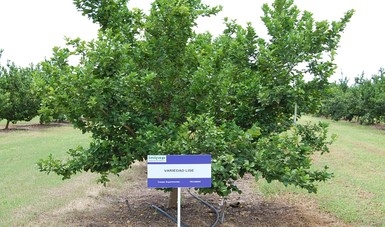Agriculture develops a new variety of lemon, which offers greater yield and adaptation for the benefit of producers in Colima and Michoacán
Experts from the Fruit Research Program of the National Institute for Forestry, Agricultural and Livestock Research (INIFAP) generated the LISE, a citrus fruit that offers better attributes and increases the diversity in quality lemons.
It's interesting how in this age of ACP and HLB, conventional citrus varieties are being developed and released. There's a lot more breeding done to find HLB resistant/tolerant selections. Maybe the idea here, is that "lemons" have a tendency towards more resistance than sweet oranges. Not as much as finger limes, but maybe this does so well in Colima that it would be hard not to plant it.
It stands out because its skin is thin, with a smooth surface, leaves of a darker green color than Colimex, contains three to five seeds, has a soft yellowish-green pulp and has nine to 12 segments and between 44 to 48 percent of acid juice.
- Experts from the Fruit Research Program of the National Institute for Forestry, Agricultural and Livestock Research (INIFAP) generated the LISE, a citrus fruit that offers better attributes and increases the diversity in quality lemons.
- It stands out because its skin is thin, with a smooth surface, leaves of a darker green color than Colimex, contains three to five seeds, has a soft yellowish-green pulp and has nine to 12 segments and between 44 to 48 percent of acid juice.
As part of the actions of the Ministry of Agriculture and Rural Development to promote and strengthen citrus producers in Mexico, the National Institute for Forestry, Agricultural and Livestock Research (INIFAP) developed the LISE variety, a Mexican lemon with high yield. better characteristics and high adaptation to producing areas in Colima and Michoacán.
Specialists from the Research Program in Fruit Trees of the Tecomán Experimental Field of INIFAP selected lemon plants with outstanding agronomic qualities and generated the "Lise", a variety that has better attributes and increases the diversity in quality citrus fruits, indicated the Institute.
The federal agency highlighted that the lemon tree blooms several times a year, with greater intensity from January to March, and is characterized by its flower buds having short petals, its fruit production extends throughout the year and its richest harvests are They get from May to September.
The skin of LISE is thin with a smooth surface, has darker green leaves than Colimex, contains three to five seeds, is soft pulp, has nine to 12 segments and produces between 44 to 48 percent juice. acid.
This new variety is the result of two cycles of selection carried out on a natural variant that did not develop thorns, through natural crosses that take into account the selections in commercial Mexican lemon plantations in Colima, explained INIFAP.
He pointed out that, according to the records of the Institute's specialists, a year yields greater than 35 tons per hectare are obtained without the presence of the citrus disease: Huanglongbing (HLB).
INIFAP specialists recommend, for practicality and economy, planting it in the rainy season in loamy soils and establishing it at a distance of six by four meters, pruning it annually, removing suckers (vegetative shoots) from the stem every three or four months and pointing the branches. long and slightly branched every six months to obtain more compact crowns.
INIFAP - a decentralized body of the Ministry of Agriculture and Rural Development - has a technological package with which it is expected that producers will obtain better yields and provides training to transfer knowledge on different varieties of lemon.
